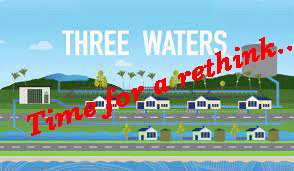Stop Press: Looks like the Three Waters Legislation will be delayed until the middle of the year
In the New Zealand Herald John Roughan, a columnist, under the heading
There may be something dirty about the Three Waters plan wrote:
Before this year is much older an unresolved argument from last year is going to bubble up again. It’s called “Three Waters”, a rather lovely name that connects the clean water we receive in a pipe with the less than lovely water we discharge in two other pipes.
When Jacinda Ardern describes the state of our three waters, I wonder if she and I are living in the same country. Everywhere I go in New Zealand I drink water from taps and it has never hurt me. When I’ve called the council about a blocked drain or sewer, workmen have quickly arrived.
True, a bug got into an artesian bore in Havelock North a few years ago, and sewage bubbled on to Wellington streets last year. But we need to be wary of water engineers and other rent-seeking professionals who will exaggerate rare mishaps to get control of public funds.
That is exactly what is proposed in the “Three Waters, case for change” published online by the Department of Internal Affairs. All water supply and disposal would be removed from elected councils and put under the control of four multi-regional “independent entities”.
These would be run by boards appointed by an “independent selection panel” some of whom would be appointed in turn by a “regional representative group” comprising equal numbers from councils and mana whenua.
The dilution of democratic influence there is breath-taking even by modern standards of managerial detachment. The voters who must pay for the services would be three steps removed from those setting their water rates.
Even at that distance, democratic representation would be shared 50-50 with mana whenua whose electoral credentials are not specified and whose interests would be unlikely to align with those who pay the bills.
Councils put up a united front against the proposals last year and the Government agreed to delay legislation until the end of February so that a working group that includes local bodies can review the accountability gap.
They could start by giving councils a power that is presently proposed exclusively for mana whenua – to issue “statements” to which the Three Waters entity would be statutorily obliged to respond. That would seem more equal “co-governance” but would still be very weak.
The whole point of Three Waters is to enable more money to be spent on water services than local bodies dare spend unless they can convince their ratepayers the expense is needed. The case for change states this quite clearly.
“Local authority service providers,” it says, “operate in a political environment in which investment decisions are made by elected representatives who have a duty to consider broader community interests and a constrained financial environment.” I’d have thought that was a good thing.
The would-be reformers cite a report from the Auditor-General: “Local authorities are not investing enough in three waters assets, indicating the assets could be deteriorating to an extent that they are unable to meet the levels of service that their communities expect.”
The key words there are “could be”. He was not sure. So, the reformers consulted a Water Industry Commission for Scotland, which reckoned New Zealand needs to spend $125b-$185b over the next 30 years to meet higher drinking water and environmental standards and population growth.
That estimate is double to triple the current value ($54.6b) of our water assets. If you are wondering what gold-plated infrastructure reformers have in mind, their document doesn’t say. All we read is that Three Waters entities will produce plans and compliance reports for a new national water regulator called Taumata Arowai.
You’ve probably not heard of it, nor had I. It’s a creature of a Water Services Act passed late last year with no press coverage that I noticed.
Taumata Arowai will require water suppliers to write drinking water safety plans, water risk management plans, keep new records, list notifiable risks and hazards and “aesthetic” values for drinking water, seek authorisations and meet monitoring schedules …
“Complying with these new requirements,” warns the case for change, “is expected to require significant capital and operating expenditure by local authorities, including paying levies to Taumata Arowai for operation of the regulatory system.”
This is sneaky reform. Three Waters is designed to relieve smaller communities of the inordinate costs of compliance with an excessive regulatory regime already enacted in law. I doubt it will make beaches and rivers one jot cleaner than current regional council efforts can achieve.

All we stand to get is another fungal outgrowth of government, four super-regional agencies, each with floors of box-ticking bureaucrats making work for contractors, consultants, researchers and publicity staff to comfort you and me, the disenfranchised suckers paying for it.
I saw a comment online this weekend that “no one should ever die from drinking tap water in NZ”.
What they seem to be proposing for Christchurch is the equivalent of every motor vehicle being governed to a maximum of 15kph in case someone dies in a motor accident.